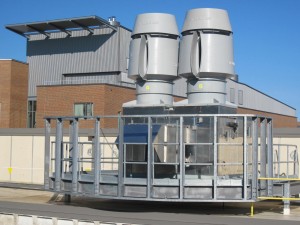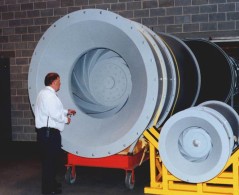A mechanical engineer recently asked; How do different types of fan blades handle the system effect? Is there a best choice when it’s hard to determine system effect?
I went to the expert on this one (no, not Rick). Paul Tetley, Vice President & General Manager, Strobic Air Corporation was kind enough to offer his opinion on this topic. Paul knows more about fan construction than any other person I know (yes, even more than Rick).
 Fan published performance data is typically based on tests that have the air entering the inlet of the fan free of swirl and with uniform air flow patterns. Any inlet condition that deviates from those designed and tested performance results has the possibility to produce a fan or system that has a de-rated performance. The result in “as tested” ideal inlet conditions compared to “as installed” conditions are commonly known as system effect.
Fan published performance data is typically based on tests that have the air entering the inlet of the fan free of swirl and with uniform air flow patterns. Any inlet condition that deviates from those designed and tested performance results has the possibility to produce a fan or system that has a de-rated performance. The result in “as tested” ideal inlet conditions compared to “as installed” conditions are commonly known as system effect.
To that end System effect factors need to be calculated to predict the installed performance of the fan or system that gives an allowance to compensate for poor (less than ideal) inlet conditions. To complicate the calculation the system effect factor needed will vary based upon the velocity, and if the velocity is not uniform entering the fan it becomes very difficult to quantify the factor needed to calculate the de-ration in fan performance that will occur.
Performance deviation in pressure, volume or energy usage is not the only thing that could be negatively impacted the fan. Reduction in bearing life, increased sound levels, increased vibration levels and even blade failure could occur as a direct result. Each fan type manufactured (axial, backward and forward curve, radial flow, cross flow and mixed flow) will react differently to system effect. Below are just a few key factors to consider when evaluating the selection of a fan when looking at the impact of poor inlet conditions.

Paul Tetley – Strobic Air Corporation
- Axial fans usually have the flow through the impeller parallel to the shaft axis and have a hub that has either fixed pitch or adjustable wings attached. The number one issue with a non uniform air flow entering this type of blade is that the amount of lift generated by the wing is based upon the velocity squared, and if the velocity is volumetrically different on the wings they will load and unload per each revolution. Thus creating a large bending moment at the point of attachment to the hub and this will result in fatigue and catastrophic failure could occur.
- In backward and forward curve, Radial flow, cross flow fans the same effect occurs but because the flow is typically radial, instead of axial, the effect of the non uniform lift generated is now being transferred into a radial plane. These blades have a back plate and in many cases a shroud that have the wings sandwiched between them that give it greater structural strength than the axial wing attachment point. The fans are still seeing high axial buffeting that causes axial shock, the energy caused by this is then transmitted onto the drive shaft in the axial plane that will reduce the life of the bearings along with higher vibration levels.
- A truly designed mixed flow impeller has both axial and radial flow characteristics and will be aerodynamically stable at any point of the pressure to volume curve. This then will generate an acceleration ratio through the blade passage ways that is constant regardless of volume and thus preventing axial shock and the above problems that that causes even though a reduced flow or pressure will occur.
Not all so called mixed flow fans are designed this way, the simple way to tell if a mixed flow fan is aero dynamically stable at all point of the P/V curve is to look at the curve and if the curve does not go all the way to the left (pressure axis) or has a dip towards that axis it is NOT a true mixed flow fan.
Post content by Paul A Tetley – Vice President & General Manager, Strobic Air Corporation
Related Blog Posts:
High Plume Dilution Fans | What Is A High Plume Dilution Fan?
High Plume Dilution Lab Exhaust Fan | Mixed Flow Fan Curve






Leave a Reply